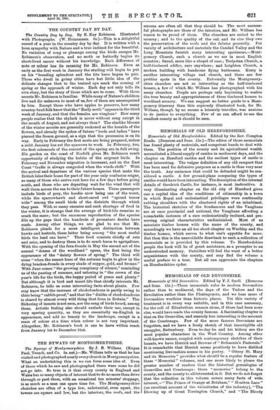THE BYWAYS OF MONTGOMERYSHIRE.
The Byways of Montgomeryshire. By J. B. Winans. (Kegan Paul, Trench, and Co. 5s. net.)—Mr. Winans tells us that he has visited and photographed nearly every church in Montgomeryshire. What an undertaking this is we can form some idea of. Even of those which he saw and photographed there were some he did not go into. So true is it that every county in England and Wales has so many objects of interest that to do no more than drive through or past them, with an occasional ten minutes' stoppage, is as much as a man can spare time for. The Montgomeryshire churches are often of a type low, substantial, even squat, the towers are square and low, but the interiors, the roofs, and the screens are often all that they should be. The most success- ful photographs are those of the interiors, and Mr. Wilkins has reason to be proud of them. The churches are suited to tho scenery ; and to the quality of the oak and its size they owe the preservation of the roofs and the fabrics generally. For variety of architecture and materials the Camlad Valley and the Long Mountain furnish many interesting specimens,—Mont- gomery Church, such a church as we see in most English counties ; Snead, more like a chapel of ease ; Trelystan Church, a half-timbered edifice, rare anywhere ; and Leighton Church, a modern building with handsome flying buttresses. Kerry is another interesting village and church, and there are few prettier spots in the county. Externally the Montgomery- shire churches are not so interesting as the half-timbered houses, a few of which Mr. Willans has photographed with his many churches. People are perhaps only beginning to realise the true beauty and appropriateness of these timbered houses to woodland scenery. We can suggest no better guide to a Mont- gomery itinerary than this copiously illustrated book, for Mr. Willans, though by no means a leisurely traveller, was anxious to do justice to everything. Few of us can afford to see the smallest county as it should be seen.


















































 Previous page
Previous page